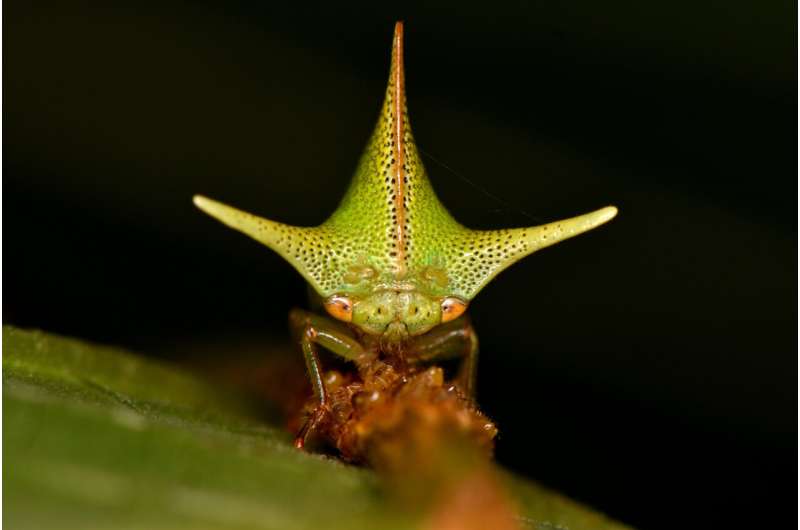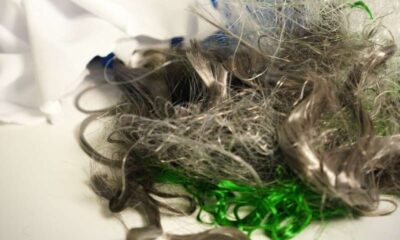Science
Treehopper Evolution Linked to Static Electricity Detection

New research from the University of Bristol suggests that the ability of treehopper insects to detect static electricity may explain their remarkable range of body shapes. Published in the Proceedings of the National Academy of Sciences on August 2, 2025, the study was led by Dr. Sam England, who completed his Ph.D. at Bristol in 2023, alongside Professor Daniel Robert, a specialist in bionanoscience.
Treehoppers, with over 3,000 species exhibiting diverse forms—ranging from horns and spines to balls and tridents—have intrigued entomologists for years. Despite extensive study, the purpose behind these unusual shapes has remained largely elusive. While some hypotheses, such as camouflage or mimicry, apply to certain species, they do not universally explain the morphological diversity observed across the treehopper family.
Dr. England and Professor Robert’s research was inspired by findings that various insects, including bees and caterpillars, possess the ability to detect static electricity. They investigated whether the extreme shapes of treehoppers could enhance their sensitivity to static electrical fields. Their experiments revealed that predatory wasps emit static electricity and that treehoppers tend to retreat from electric fields.
Through computational modeling, the researchers demonstrated that the unique body structures of treehoppers amplify the electric field around them, potentially heightening their ability to sense static electricity. Notably, the study found that predatory wasps possess distinct electrostatic charges—both in magnitude and polarity—when compared to the friendly stingless bees that provide protection to treehoppers. This suggests that treehoppers may differentiate between friends and foes based solely on electrical signals.
Dr. England commented on the implications of their findings, stating, “We think our study provides a really exciting launch pad for investigating static electricity as a driver of organismal morphology more generally.” He noted that many insects, spiders, and other organisms exhibit extreme shapes that lack clear explanations, and their research offers the first evidence that electroreception may influence morphological evolution.
Looking ahead, the researchers aim to explore how various treehopper shapes adapt to different electrical environments. Dr. England emphasized the importance of linking treehopper morphology to specific aspects of their electrical ecology. “If we can connect treehopper shapes to particular predators that approach from certain angles with unique static charges, this would strongly support our ideas around static electricity as an evolutionary driver,” he added.
This groundbreaking study paves the way for further investigation into the role of static electricity in the evolution of diverse body shapes across various species. As researchers continue to unravel the complexities of insect morphology, the insights gained from treehoppers may illuminate broader principles of evolutionary biology.
For more details, refer to the study: Sam J. England et al, “Electroreception in treehoppers: How extreme morphologies can increase electrical sensitivity,” Proceedings of the National Academy of Sciences (2025). DOI: 10.1073/pnas.2505253122.
-

 Lifestyle2 weeks ago
Lifestyle2 weeks agoBelton Family Reunites After Daughter Survives Hill Country Floods
-

 Education3 weeks ago
Education3 weeks agoWinter Park School’s Grade Drops to C, Parents Express Concerns
-

 Technology2 weeks ago
Technology2 weeks agoDiscover the Top 10 Calorie Counting Apps of 2025
-

 Technology3 weeks ago
Technology3 weeks agoByteDance Ventures into Mixed Reality with New Headset Development
-

 Technology3 weeks ago
Technology3 weeks agoMeta Initiates $60B AI Data Center Expansion, Starting in Ohio
-

 Technology5 days ago
Technology5 days agoHarmonic Launches AI Chatbot App to Transform Mathematical Reasoning
-

 Lifestyle3 weeks ago
Lifestyle3 weeks agoNew Restaurants Transform Minneapolis Dining Scene with Music and Flavor
-

 Technology2 weeks ago
Technology2 weeks agoMathieu van der Poel Withdraws from Tour de France Due to Pneumonia
-

 Technology3 weeks ago
Technology3 weeks agoGlobal Market for Air Quality Technologies to Hit $419 Billion by 2033
-

 Technology3 weeks ago
Technology3 weeks agoRecovering a Suspended TikTok Account: A Step-by-Step Guide
-

 Health3 weeks ago
Health3 weeks agoSudden Vision Loss: Warning Signs of Stroke and Dietary Solutions
-

 Technology3 weeks ago
Technology3 weeks agoTrump Faces Internal Struggles Over Epstein Files Handling















